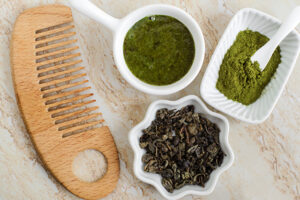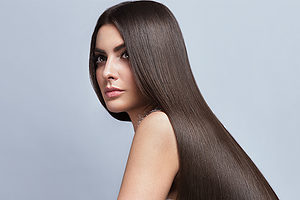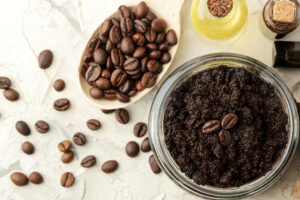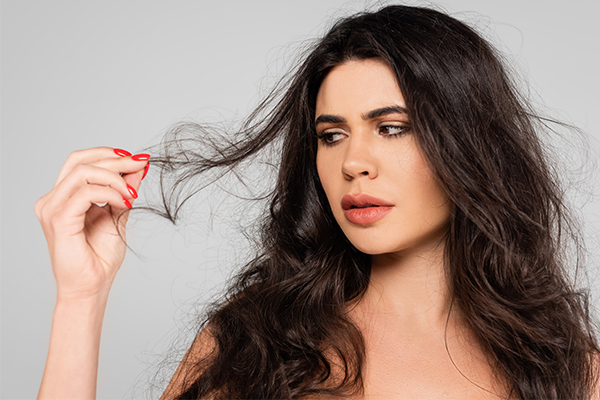Most people skip out on conditioner after washing their hair because they feel it is already squeaky clean and they don’t want to weigh their hair down and make it feel greasy.
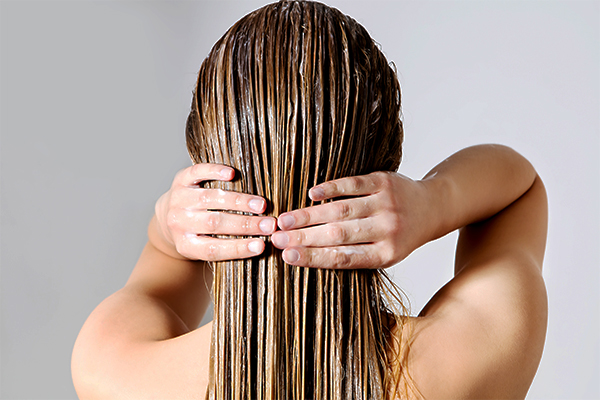
The truth is that a conditioner is just as crucial as a moisturizer is for the skin. It helps to hydrate and protect your hair from breakage, pollution, damage, and more.
The best way to apply conditioner is from the mid-lengths to the ends. Allow it to stay on your hair for 2–3 minutes, and then gently work it into your hair to smoothen the cuticles.
If you haven’t been getting the results you ought to get from using conditioner, you must be doing something wrong.
Here are seven mistakes you could be making when applying conditioner to your hair.
Hair Conditioner Mistakes
Avoid these common mistakes when using a hair conditioner on your hair and scalp.
1. Applying it to the roots
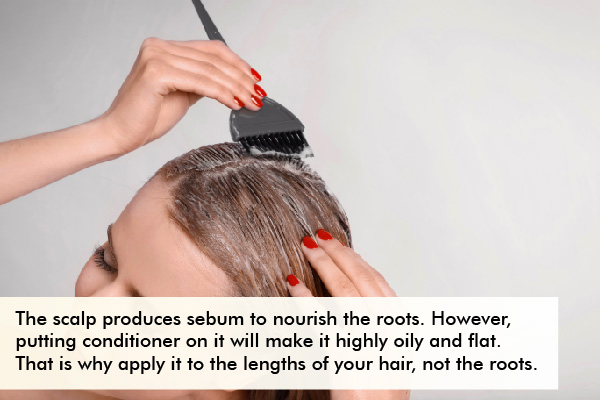
Applying conditioner to the roots is the most common mistake people commit. As the scalp produces sebum to nourish the roots, putting conditioner on it will make it extremely oily and flat. This is why you need to apply it to the lengths of your hair and not the roots.
Always apply conditioner from the mid-length of the hair to the tips, which are the oldest and driest parts of your tresses. Allow the conditioner to remain in your hair for 2–3 minutes to be absorbed fully by the hair and then wash it off with cool water. (1)
2. Applying it in reverse
This latest TikTok trend is disrupting the usual way people wash their hair. It promotes the application of conditioner first and keeping it on your hair for 3–4 minutes and then rinsing it off, followed by shampoo application to the scalp and hair and then another rinse.
This process is a no-no because shampooing completely strips the hair from every trace of the conditioner, leaving it dry and prone to frizz. (1)
3. Not deep conditioning
Apart from a regular hair wash session, your tresses need deep hair conditioning every six weeks. Deep conditioning your hair with nourishing and hydrating hair masks promotes hair elasticity, restores the hair’s pH, increases shine, and improves the hair texture. (2)
The type of conditioner you use on your hair will depend on the condition of your hair and scalp. You can make your own deep-conditioning hair mask at home using natural ingredients such as coconut oil, (3) bhringraj oil, (4) onion juice, olive oil, (5) fenugreek powder, saw palmetto, green tea extract, (4) and curry leaves. (6)
All these ingredients are 100% natural and highly beneficial – they keep the scalp free from bacteria and fungi, reduce hair loss, and promote hair growth.
4. Applying the wrong amount
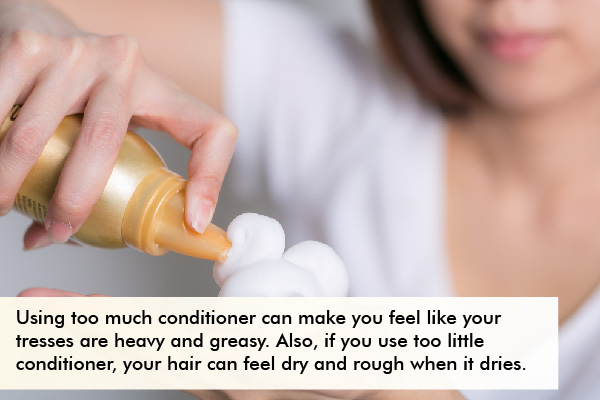
When stepping out of the shower, do you feel like your tresses are heavy and greasy? It could be because you have used too much conditioner on your hair. Also, if you use too little conditioner, your hair can feel dry and rough when it dries.
The best way to know how much conditioner to use on your hair is to apply a coin sized amount of the product and apply it in your hair. If your fingers can easily glide through your tresses, you have used enough conditioner. But if not, add another coin sized amount at a time till your locks are easily combable.
If you have fine hair, you need not condition your hair every time, but make sure you do so once a week with a light conditioner. (2)
5. Using a 2-in-1 shampoo and conditioner
People always look for convenience in everything, so here comes 2-in-1 shampoos and conditioners. They are advertised to clean and condition your hair simultaneously, thereby saving you time and money, but they end up doing more damage to the hair than good.
Shampoos and conditioners have different roles – shampoo is used to clean the scalp of dirt, sebum, and buildup, whereas a conditioner is used on the lengths of the hair to nourish and hydrate it.
So, when you use a 2-in-1 shampoo and conditioner on the scalp and hair, it leaves you with product buildup on your scalp that can lead to hair loss and poor hair growth in the future. (2)
However, those with dry, damaged, or chemically treated hair can use a 2-in-1 shampoo and conditioner to wash their hair daily. (2)
6. Leaving it on for too long
Letting the conditioner sit in your hair for too long can weigh your hair down and make it greasy. The trick is to leave it in your hair for 2–3 minutes before washing it off with cool water.
7. Using a conditioner with harmful ingredients
While shopping for conditioners, read the product label carefully and avoid those containing parabens, sulfates, fragrances, and other such ingredients as they are harmful to the hair and are not natural.
Instead, choose hair conditioners made from natural oils such as coconut oil, jojoba oil, argan oil, and onion juice, as they contain nourishing and hydrating agents that make your hair soft and silky. (7)
General Queries Related to Hair Conditioners
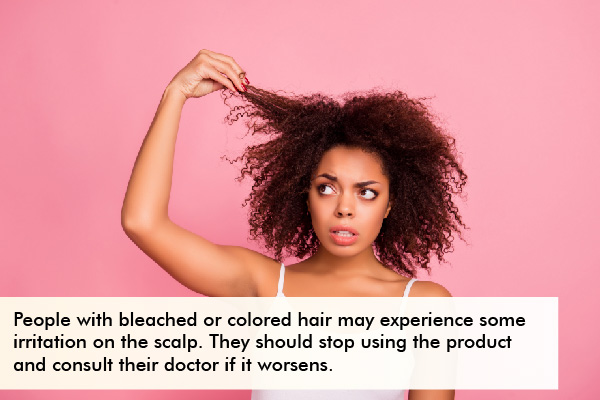
Are there any side effects to using hair conditioners?
People with bleached or colored hair may experience some irritation on the scalp. If it worsens, they should stop using the product and consult their doctor.
Should I use conditioner on oily hair?
Conditioner is necessary even for oily hair because it provides hydration, nourishment, and protection to your locks.
Can I use a hair conditioner every day?
You can use conditioner twice or thrice a week after washing your hair with shampoo.
Final Word
Conditioners provide hydration and a protective coating to the hair. It should never be applied directly to the scalp but only to the lengths of the hair.
Avoid making the mistakes listed above when using conditioner on your hair and you will reap its effects in no time.
References
- Gavazzoni Dias MFR. Hair cosmetics: An overview. International journal of trichology. https://www.ncbi.nlm.nih.gov/pmc/articles/PMC4387693/. Published 2015.
- D’Souza P, Rathi SK. Shampoo and conditioners: What a dermatologist should know? Indian journal of dermatology. https://www.ncbi.nlm.nih.gov/pmc/articles/PMC4458934/. Published 2015.
- Saxena R, Mittal P, Clavaud C, et al. Longitudinal Study of the scalp microbiome suggests coconut oil to enrich healthy scalp commensals. Scientific reports. https://www.ncbi.nlm.nih.gov/pmc/articles/PMC8012655/. Published March 31, 2021.
- Umar S, Carter MJ. A multimodal hair-loss treatment strategy using a new topical phytoactive formulation: A report of five cases. Case reports in dermatological medicine. https://www.ncbi.nlm.nih.gov/pmc/articles/PMC7878086/. Published February 4, 2021.
- Ezekwe N, King M, Hollinger JC. The use of natural ingredients in the treatment of alopecias with an emphasis on central centrifugal cicatricial alopecia: A systematic review. The Journal of clinical and aesthetic dermatology. https://www.ncbi.nlm.nih.gov/pmc/articles/PMC7595365/. Published August 2020.
- Balakrishnan R, Vijayraja D, Jo S-H, Ganesan P, Su-Kim I, Choi D-K. Medicinal profile, phytochemistry, and pharmacological activities of Murraya koenigii and its primary bioactive compounds. Antioxidants (Basel, Switzerland). https://www.ncbi.nlm.nih.gov/pmc/articles/PMC7070712/. Published January 24, 2020.
- HM; CCHHSHW. A review: Hair health, concerns of shampoo ingredients and scalp nourishing treatments. Current pharmaceutical biotechnology. https://pubmed.ncbi.nlm.nih.gov/26278532/.



